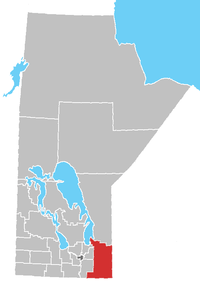Shoal Lake 40 First Nation
Shoal Lake 40 First Nation is an Ojibway or Ontario Saulteaux First Nation reserve located in the Eastman Region of Manitoba and the Kenora District of Ontario. The total registered population in August 2011 was 568, of which the on-reserve population was 266.[1] The first Nation is a member of the Bimose Tribal Council, a Regional Chief's Council that is a member of the Grand Council of Treaty 3.
This First Nation's community inhabits a man-made island. It is accessible via barge traffic from Iskatewizaagegan 39 First Nation's dock, located in the community of Kejick, Ontario, and in winter by ice roads. An all-season road to bridge the community with the Trans-Canada Highway is currently in the planning stages.[2]
The First Nation possess basic infrastructure, limited retail outlets, indoor and outdoor recreational facilities and provide local elementary schooling to Grade 8.
History
Indian Bay and drinking water
In 1980, both First Nation bands in this area (#39 and #40) planned to develop 350 cottage lots on Indian Bay, Shoal Lake. This project was opposed by the City of Winnipeg due to concerns about the safety of its drinking water, which is drawn from Indian Bay.[3] The dispute was settled in 1989 when the Greater Winnipeg Water District placed $6 million in trust for Shoal Lake 40 with the interest to be used to fund alternative development projects. The agreement was conditional on a contribution of $3 million from the federal government.[4] A tripartite agreement was finalized when a parallel agreement was signed between the federal government and Shoal Lake 40 in 1990.[5][6] In the mean time Shoal Lake began importing water by barge or truck at a substantial cost.[5]
In 2011, when the proposal for a new water treatment plant showed that the cost would be more than anticipated, the Federal government refused to contribute the difference and the plan was abandoned. Instead, Shoal Lake proposed the construction of an all-weather road to guarantee safe year-round access to the reserve and for the importation of water.[5]
Freedom Road
Shoal Lake 40 joined forces with the neighbouring Manitoba municipality of Reynolds to encourage the building of an all-weather road by two levels of government, in order to connect with the Trans-Canada Highway.[5] In earlier years, the community obtained many necessary supplies and goods via the Greater Winnipeg Water District Railway as they were shipped to the aqueduct water intake site. This terminus site for the railway was also known as Waugh Station.
In 2015, the government had agreed to pay for a design project for the study, but would not promise to pay for the construction of "Freedom Road" itself.[7][8] Earlier in the year, the community's ferrybarge failed to pass inspection and the local leadership declared a state of emergency.[7]
Reserves
This First Nation occupies three reserves:
- 2579 ha Shoal Lake 40, which serves as their main Reserve, containing the community of Indian Bay, Manitoba[9]
- 172.4 ha Shoal Lake 34B2 Indian Reserve[10]
- 379 ha Agency 30 Indian Reserve, which is shared with 12 other First Nations[11]
Governance
Shoal Lake 40 First Nation elects their leadership through the Act Electoral System for two year terms.
Chief and Council
- 2014-Present: Chief Erwin Redsky and 4 Councillors: Brenda Freel, Herbert Green, Vernon Redsky and Billy Wahpay.[12]
- 2012-2014: 2014-Present: Chief Erwin Redsky and 4 Councillors: Herbert Green, Vernon Redsky, Tania Bruyere, and Preston Green.[13][12]
- 2010-2012: Chief Erwin Redsky and 4 Councillors: Tom Anderson, Marcella Meekis, Vernon Redsky and Billy Wahpay.
References
- ↑ Shoal Lake No.40 - Registered Population as of August, 2011. Indian and Northern Affairs Canada. Retrieved 8 September 2011.
- ↑ Freedom Road on hold? -Shoal Lake road doesn’t seem to be moving forward as Tories investigate Winnipeg Sun. Retrieved 9 October 2016.
- ↑ Shoal Lake Aqueduct, Winnipeg, Manitoba. The National History Committee of the Canadian Society for Civil Engineering, 1994. Retrieved 7 September 2011.
- ↑ Agreements and Licenses - Urban Water Quality: Shoal Lake. Winnipeg Green Map - Source and Supply. Retrieved 14 September 2011.
- 1 2 3 4 At the mouth of the aqueduct, there's no water to drink. Winnipeg Free Press, 8 January 2011. Retrieved 7 September 2011.
- ↑ "List of Selected Treaties, Intergovernmental Agreements, Memoranda of Understanding, Orders, Draft Documents, etc. of Specific Relevance to the Shoal Lake Watershed." Government of Manitoba, Dept. of Water Stewardship. Retrieved 14 September 2011.
- 1 2 Puxley, Chinta (25 Jun 2015). "Shoal Lake reserve residents weep as Ottawa balks at funding road construction". CBC News. Retrieved 27 June 2015.
- ↑ Road to isolated Shoal Lake First Nation a long-awaited step in tangled history. CBC News, 17 December 2015. Retrieved 20 November 2016.
- ↑ Aboriginal Canada Portal - Shoal Lake No.40. Retrieved 7 September 2011.
- ↑ Aboriginal Canada Portal - Shoal Lake 34B2. Retrieved 7 September 2011.
- ↑ Aboriginal Canada Portal - Agency 30. Retrieved 7 September 2011.
- 1 2 Hale, Alan S. (7 March 2014). "Erwin Redsky wins another term as chief of Shoal Lake 40, half of band council replaced". Kenora Daily Miner and News. Retrieved 27 June 2015.
- ↑ Thompson, Jon (March 1, 2012). "Redsky returns as Shoal Lake 40 chief". Kenora Daily Miner and News. Retrieved 27 June 2015.
External links
- Official website
- AANDC profile
- profile from Chiefs of Ontario
- Map of Shoal Lake 40 (Part), Manitoba at Statcan
- Map of Shoal Lake 40 (Part), Ontario at Statcan
- Map of Shoal Lake 34B2, Ontario at Statcan
Coordinates: 49°36′45″N 95°08′41″W / 49.61250°N 95.14472°W

